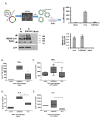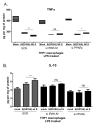Middle east respiratory syndrome corona virus spike glycoprotein suppresses macrophage responses via DPP4-mediated induction of IRAK-M and PPARγ
- PMID: 28118607
- PMCID: PMC5354714
- DOI: 10.18632/oncotarget.14754
Middle east respiratory syndrome corona virus spike glycoprotein suppresses macrophage responses via DPP4-mediated induction of IRAK-M and PPARγ
Abstract
Middle East Respiratory Syndrome Corona Virus (MERS-CoV) is transmitted via the respiratory tract and causes severe Acute Respiratory Distress Syndrome by infecting lung epithelial cells and macrophages. Macrophages can readily recognize the virus and eliminate it. MERS-CoV infects cells via its Spike (S) glycoprotein that binds on Dipeptidyl-Peptidase 4 (DPP4) receptor present on macrophages. Whether this Spike/DPP4 association affects macrophage responses remains unknown. Herein we demonstrated that infection of macrophages with lentiviral particles pseudotyped with MERS-CoV S glycoprotein results in suppression of macrophage responses since it reduced the capacity of macrophages to produce TNFα and IL-6 in naive and LPS-activated THP-1 macrophages and augmented LPS-induced production of the immunosuppressive cytokine IL-10. MERS-CoV S glycoprotein induced the expression of the negative regulator of TLR signaling IRAK-M as well as of the transcriptional repressor PPARγ. Inhibition of DPP4 by its inhibitor sitagliptin or siRNA abrogated the effects of MERS-CoV S glycoprotein on IRAK-M, PPARγ and IL-10, confirming that its immunosuppressive effects were mediated by DPP4 receptor. The effect was observed both in THP-1 macrophages and human primary peripheral blood monocytes. These findings support a DPP4-mediated suppressive action of MERS-CoV in macrophages and suggest a potential target for effective elimination of its pathogenicity.
Keywords: DPP4; IRAK-M; Immune response; Immunity; Immunology and Microbiology Section; MERS CoV; cytokines; macrophages.
Conflict of interest statement
The authors have no conflicts of interest to declare.
Figures







References
-
- Zaki AM, van Boheemen S, Bestebroer TM, Osterhaus AD, Fouchier RA. Isolation of a novel coronavirus from a man with pneumonia in Saudi Arabia. N Engl J Med. 2012;367:1814–20. - PubMed
-
- Kucharski AJ, Althaus CL. The role of superspreading in Middle East respiratory syndrome coronavirus (MERS-CoV) transmission. Euro Surveill. 2015;20 - PubMed
-
- Assiri A, Al-Tawfiq JA, Al-Rabeeah AA, Al-Rabiah FA, Al-Hajjar S, Al-Barrak A, Flemban H, Al-Nassir WN, Balkhy HH, Al-Hakeem RF, Makhdoom HQ, Zumla AI, Memish ZA. Epidemiological, demographic, and clinical characteristics of 47 cases of Middle East respiratory syndrome coronavirus disease from Saudi Arabia: a descriptive study. Lancet Infect Dis. 2013;13:752–61. - PMC - PubMed
-
- Drosten C, Seilmaier M, Corman VM, Hartmann W, Scheible G, Sack S, Guggemos W, Kallies R, Muth D, Junglen S, Muller MA, Haas W, Guberina H, et al. Clinical features and virological analysis of a case of Middle East respiratory syndrome coronavirus infection. Lancet Infect Dis. 2013;13:745–51. - PMC - PubMed
MeSH terms
Substances
LinkOut - more resources
Full Text Sources
Other Literature Sources
Miscellaneous

